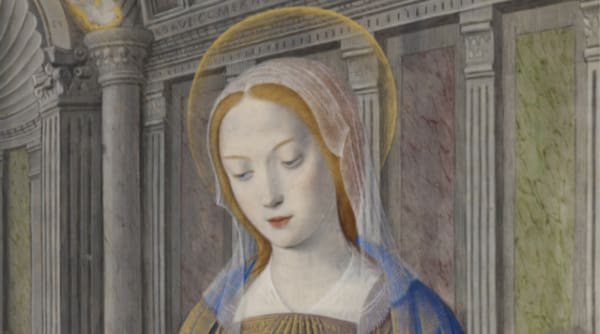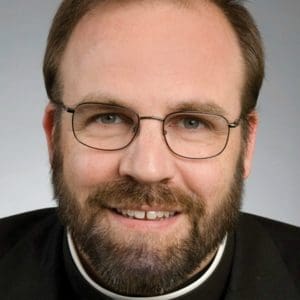Tuesday’s Solemn Feast of the Immaculate Conception is often mistakenly thought to refer to the conception of Jesus in the womb of the Blessed Mother. It does not. Perhaps it does not help the confusion that the Gospel chosen for today’s feast is in fact the gospel of the Annunciation wherein Jesus is conceived in Mary’s womb by the power of the Holy Spirit. There is a reason this Gospel is chosen as we shall later see. However, the Dogma of the Immaculate Conception refers to Mary’s Conception in the womb of her mother Anne. The Dogma is stated as follows in the Papal Document Ineffabilis Deusissued by Pope Pius IX in 1854:
The Most-holy Virgin Mary was, in the first moment of her conception, by a unique gift of grace and privilege of Almighty God, in view of the merits of Jesus Christ, the Redeemer of Mankind, preserved free from all stain of Original Sin (D 1641).
Note how carefully the Dogma is worded. Mary receives this gift from God on account of the merits of Jesus Christ. Hence we do not teach that Mary was not in need of the saving grace of Jesus Christ, for it is only by his merits that she is able to receive this gift.
Why does the Church teach this? Perhaps we can look at it from three perspectives:
1. Fittingness– When we consider the fittingness of something we do not deny that God could have done things otherwise. We argue only that what he did makes sense and is in accord with what seems best. For example, Jesus could have chosen to appear on earth as a full-grown man, never having been born, never having been a child or a carpenter. It was surely possible for God to have done this. He could have created a human nature for himself ex nihilo (from nothing). However it seems fitting that the Lord Jesus lived life as we do, having been conceived, born, raised, nurtured, come to manhood, labored, and finally ministered. So the Lord chose to have for himself a mother and, from this mother, to draw his humanity.
But what sort of humanity would he need to draw from her? It seems clear that the humanity he drew from her had to be sinless since Scripture says of Jesus: For we do not have a high priest who is unable to sympathize with our weaknesses, but we have one who has been tempted in every way, just as we are–yet was without sin. (Heb 4:15). And again, Which of you can accuse me of sin? (John 8:46). So the humanity that Christ drew from Mary was sinless. But Mary cannot give what she does not have. So it is fitting that God preserved her at her conception from the stain (macula) of Original Sin. Hence she is called Immacula (without stain).
Now one might argue that God could simply have done for Christ what he did for Mary and simply intervened at the moment of Christ’s conception and preserved him free of that stain while leaving Mary with it. This is true, but less fitting. For if Christ did not take all of his humanity from Mary then incarnation becomes something of a charade, incomplete at best. Christ would have taken some of his humanity from Mary and some from…..where? Hence it is more fitting that Mary be preserved and that Christ’s sonship of Mary be full and her Maternity be full.
It is also fitting that Mary be preserved from Original Sin due to her status as the New Eve. Mary fulfills the text of Genesis 3:15: And I will put enmity between you and the woman, and between your offspring and hers; he will crush your head, and you will strike his heel. So Mary is the woman, the new Eve, spoken of in this text. But the first Eve was created sinless. Hence it is fitting that the second Eve also be created sinless. In effect, God is revisiting the original scenario wherein we were harmed by a man, a woman, and a tree. Hence God decrees that we would be restored in the same way: a man (Christ), a woman (Mary), and the tree of the cross. Hence Christ saves us by the wood of the Cross and his obedience. But, just as the original scenario also featured a sinless woman who disobeyed, now another sinless woman would, this time, obey. It is thus fitting that Mary be sinless as the New Eve.
2. Faithfulness to Scripture – The Gospel chosen for today may confuse some for it is the gospel that refers to Christ’s conception. However it is chosen for the fact of what the Angel Gabriel says to Mary: And coming to her, he said, “Hail, full of grace! The Lord is with you (Lk 1:28). There is a Greek word underlying the translation “full of grace” and the word is kecharitomene. The meaning of this term is much disputed since it is a hapax legomenon(a word that only occurs once in the whole of Scripture). The great scholar, Greek speaker and Father of the Church Origen said of this word: The angel greeted Mary with a new address which I could not find anywhere else in scripture….This greeting was reserved for Mary alone (Hom 6.7 on Luke).
However, at the heart of the word is the Greek word charitoo which means to show forth grace (charis), or in the passive to have grace shown. Kecharitomene is a perfect, passive, participle of charitoo and hence means endowed with grace (charis). But what does it mean to say it is a perfect participle? A participle is a word that has both the qualities of an adjective and a verb. The ‘perfect’ action of the participle is considered to have been completed before the time of the speaker. How long before is not a consideration, but the Greek verbal idea is that the action has already been completed. Perfected action must imply the past in relationship to the speaker. Thus, Gabriel in using the word is confessing that Mary had already been graced. So, the most literal rendering of kecharitomene is “having been endowed with grace.” That is awkward in English however: “Hail! having been endowed with grace, the Lord is with thee!” 
Now, grammar aside, it would be strange for Gabriel to say to a woman who had Original Sin that she was full of grace. In no way can the word be implied to mean that she will one day be graced since it is a past participle. The action of her being made full of grace is past, though its effects are present now. So Gabriel is greeting her in this condition. Hence the text implies some prior action of God. Now, this does not ipso facto prove that the moment in the past where God acted was her conception. But, this seems the most fitting timing since Original Sin is contracted at that moment. Gabriel’s greeting only makes sense if Mary is free from Original Sin, for grace and Original Sin are not compatible
But the point remains that Catholic teaching on Mary’s freedom from Original Sin is most faithful to the Scriptural text here. The Angel’s greeting is significant and Catholic teaching best connects the dots, and takes the greeting at its word, respecting its plain meaning. Mary, having been made full of grace, is free from Original Sin.
3. Fathers of the Church– The Church Fathers did not use the term Immaculate Conception but they did teach on Mary’s holiness and sinlessness. Here are some quotes:
- St. Ephrem, 3rd Century – Thou and thy Mother are the only ones who are totally beautiful in every respect; for in thee O Lord there is no spot and in thy Mother, no stain. (Carmina Nisibena, 27.8).
- Hippolytus 3rd Century – The Lord was sinless, because in His humanity He was fashioned out of incorruptible wood, that is to say, out of the Virgin and the Holy Spirit (In Psalm 22; quoted by Theodoret, Dialogus 1; PG 10:610, 864-5)
- St. Augustine 4th Century – All men must confess themselves as sinners except the Holy Virgin Mary, whom I desire for the sake of the honor of the Lord to leave entirely out of the question when the talk is of sin. For from Him we know what abundance of grace for overcoming sin in every particular was conferred upon her who had the merit to conceive and bear Him who undoubtedly had no sin.” (De Natura et gratia 36.42)
- St. Ephrem, 3rd Century – Mary and Eve, two people without guilt, two simple people were identical. Later however, one became the cause of our death, the other the cause of our life (Opus Syr. II, 327)
- Origen, 3rd Century – This Virgin Mother of the Only-begotten of God, is called Mary, worthy of God, immaculate of the immaculate, one of the one. (Homily 1)
- St Ambrose – 4th Century – “Mary, a Virgin not only undefiled but a Virgin whom grace has made inviolate, free of every stain of sin.” (Sermon 22:30)
In the end, Mary receives this honor to be free of original sin for the sake of Christ. All the great Marian doctrines refer back to Christ. Mary too, as the perfect disciple, and Mother of the Church also prefigures the gifts that we will one day enjoy. For, in heaven, having been freed of all our sins and purified by the blood of Christ, we too will be rightfully called Immaculate (without stain). So Mary’s Feast is ours too by way of promise.
There is a beautiful text for today’s feast which says,
Tota pulchra es, Maria,
et macula originalis non est in te.
Vestimentum tuum candidum quasi nix, et facies tua sicut sol.
Tu gloria Jerusalem, tu laetitia Israel, tu honorificentia populi nostri.
Tota pulchra es, Maria.
You are all beautiful, Mary,
and the original stain [of sin] is not in you.
Your clothing is bright as snow, and your face is like the sun.
You are the glory of Jerusalem, you are the joy of Israel, you give honour to our people.
You are all beautiful, Mary.
Here is a setting by Durufle:
Image credit: The British Library on Unsplash.





